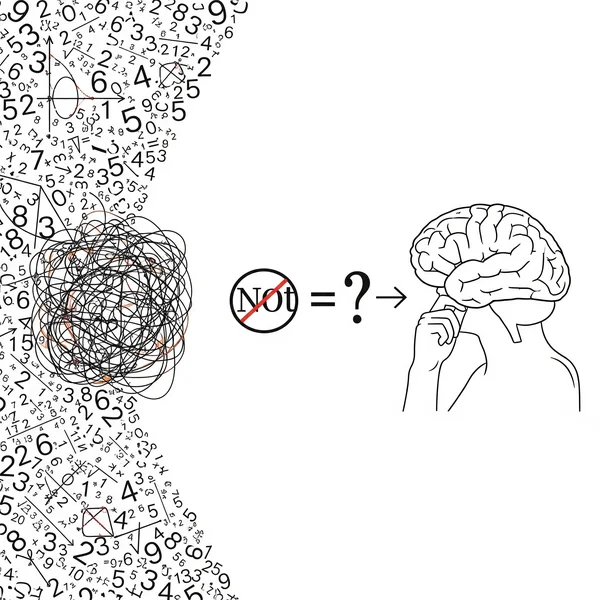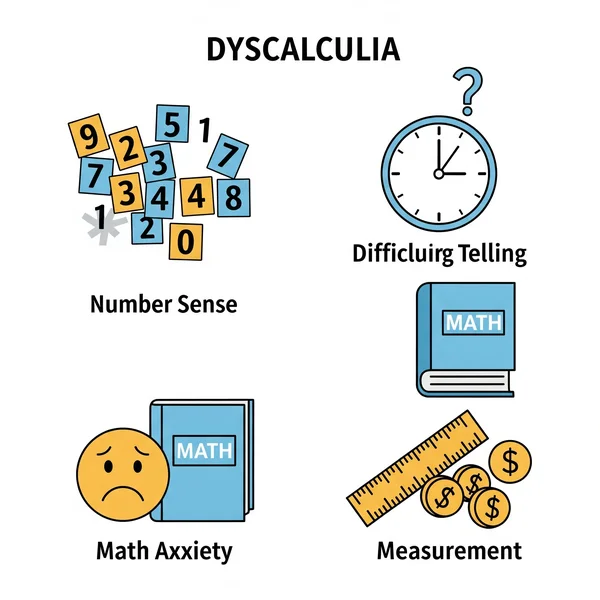Difficulté à lire l'heure : un signe de dyscalculie ? Guide pour les parents
La difficulté à lire l'heure est-elle un signe de dyscalculie ? Ce que les parents et les éducateurs doivent savoir sur ce signe et les autres symptômes de la dyscalculie.
En tant que parent ou enseignant, vous avez certainement accompagné un enfant dans l'apprentissage de l'heure. Pour la plupart, c'est une compétence acquise avec la pratique. Mais que se passe-t-il si un enfant a constamment du mal, beaucoup plus que ses camarades, à comprendre comment fonctionne une horloge analogique ? La difficulté à lire l'heure est-elle un signe de dyscalculie ? C'est une question cruciale, car des difficultés persistantes avec les concepts de temps peuvent en effet être l'un des nombreux signes de dyscalculie. Ce guide vise à aider les parents et les éducateurs à comprendre les divers symptômes de la dyscalculie, y compris la dyscalculie liée à la lecture de l'heure, et à reconnaître quand ces difficultés d'apprentissage pourraient justifier une attention particulière. Une sensibilisation précoce est essentielle, et si vous recherchez des informations, des outils comme un test de dyscalculie en ligne peuvent être un point de départ.
Comprendre la dyscalculie : plus que de simples "mauvaises notes en maths"

Avant de plonger dans les symptômes spécifiques, il est important de comprendre ce qu'est la dyscalculie - et ce qu'elle n'est pas. Qu'est-ce que la dyscalculie ?
Qu'est-ce que la dyscalculie ? Un bref aperçu
La dyscalculie est un trouble d'apprentissage spécifique qui affecte la capacité d'une personne à acquérir des compétences en arithmétique. Les personnes atteintes de dyscalculie peuvent avoir des difficultés à comprendre les nombres, à apprendre à manipuler les nombres, à apprendre les faits mathématiques et un certain nombre d'autres difficultés connexes. C'est une condition cérébrale et n'est pas liée à l'intelligence générale. Elle est souvent appelée "dyslexie des maths" ou trouble d'apprentissage en mathématiques, bien qu'elle soit distincte.
Idées fausses courantes sur les troubles d'apprentissage en mathématiques
Il ne s'agit pas de paresse ou de manque d'efforts. Les enfants atteints de dyscalculie peuvent faire de gros efforts et pourtant avoir du mal avec les difficultés avec les concepts mathématiques fondamentaux. De plus, tous les enfants qui ont du mal avec les maths ne sont pas atteints de dyscalculie ; d'autres facteurs peuvent jouer un rôle.
Pourquoi l'identification précoce de la dyscalculie est importante pour le soutien
L' identification précoce de la dyscalculie est cruciale. Plus la dyscalculie est reconnue tôt, plus tôt un soutien et des interventions appropriés peuvent être mis en place. Cela peut éviter des années de frustration, renforcer la confiance et aider les enfants à développer des stratégies d'adaptation pour réussir en mathématiques et dans les tâches de la vie quotidienne impliquant des nombres, comme la gestion de l'argent ou, en effet, la lecture de l'heure.
Principaux signes et symptômes de la dyscalculie chez les enfants à surveiller

Quels sont les signes de la dyscalculie chez les enfants ? La dyscalculie se manifeste de diverses manières et les symptômes peuvent varier selon l'âge. Voici quelques signes de dyscalculie courants à connaître :
Difficulté persistante avec le sens élémentaire des nombres
C'est souvent un indicateur central. Recherchez :
- Difficulté à compter : Difficulté à apprendre à compter, à perdre fréquemment le fil ou à avoir du mal à compter à rebours. Ce sont des difficultés courantes de comptage.
- Reconnaissance des nombres : Difficulté à relier un symbole numérique (par exemple, "7") à sa quantité.
- Comparaison des quantités : Difficulté à identifier quel nombre est le plus grand ou le plus petit. Ces difficultés de compréhension des nombres sont fondamentales.
Difficultés avec les concepts et les opérations mathématiques
Au-delà des nombres de base, la compréhension des idées mathématiques peut être difficile :
- Difficultés avec l'addition, la soustraction, la multiplication, la division : Difficulté à mémoriser les faits mathématiques ou à comprendre les processus impliqués dans ces difficultés arithmétiques.
- Compréhension de la valeur de position : Confusion au sujet des dizaines, des centaines, etc.
- Difficulté avec les fractions ou d'autres concepts mathématiques.
Difficulté avec la mesure, l'argent et... la lecture de l'heure (le lien avec la dyscalculie)
La dyscalculie a souvent un impact sur les applications mathématiques dans le monde réel :
- Difficultés avec les mesures (longueur, poids, volume, etc.)
- Rendre la monnaie ou manipuler des sommes d'argent.
- Lecture des horloges analogiques (dyscalculie liée à la lecture de l'heure) : C'est un point important, car cela implique le séquençage des nombres, le raisonnement spatial et la compréhension des parties d'un tout (minutes dans une heure).
Difficultés de raisonnement spatial et mathématiques
La dyscalculie visuo-spatiale peut se manifester par :
- Problèmes de géométrie : Difficulté à comprendre les formes, les espaces et leurs relations.
- Problèmes avec les graphiques ou la visualisation de problèmes mathématiques.
- Difficulté à aligner les nombres en colonnes pour les calculs.
Anxiété mathématique et comportements d'évitement
Des difficultés constantes peuvent entraîner une anxiété liée aux mathématiques (ou anxiété mathématique) :
- Réactions émotionnelles négatives aux tâches mathématiques : Se sentir stressé, anxieux ou même physiquement mal à l'aise face aux mathématiques.
- Évitement des activités impliquant des nombres ou des mathématiques.
Comment la difficulté à lire l'heure est-elle liée aux symptômes de la dyscalculie ?
La difficulté à lire l'heure est-elle un signe de dyscalculie ? Oui, cela peut certainement être un signe important. Le lien entre la dyscalculie liée à la lecture de l'heure et les symptômes plus larges de la dyscalculie réside dans les exigences cognitives partagées :
Problèmes de ligne numérique et de séquençage affectant la lecture de l'heure
Une horloge analogique est essentiellement une ligne numérique circulaire. La compréhension de la séquence des nombres 1 à 12, puis l'application des intervalles de 5 minutes nécessitent de solides compétences en séquençage, qui sont souvent faibles dans la dyscalculie chez les enfants.
Compréhension des fractions de temps (demi, quart) en tant que concept numérique
Les termes comme "et demie" ou "moins le quart" sont des concepts fractionnaires. Les difficultés avec les fractions sont une caractéristique de la dyscalculie et ont un impact direct sur la compréhension de ces expressions temporelles courantes.
Défis visuo-spatiaux dans l'interprétation du cadran de l'horloge et des mouvements des aiguilles
Juger avec précision la position des aiguilles des heures et des minutes, comprendre leur relation et visualiser leur mouvement implique des compétences visuo-spatiales. Les déficits à ce niveau peuvent rendre la lecture de l'heure confuse.
Surcharge de la mémoire de travail lors de calculs temporels complexes.
Lire une horloge (par exemple, savoir que l'aiguille des minutes sur le 7 signifie 35 minutes, et que l'aiguille des heures s'approche du 4, donc il est 3h35) nécessite de retenir et de traiter simultanément plusieurs éléments d'information, ce qui peut solliciter la mémoire de travail, un autre domaine souvent touché par les difficultés d'apprentissage comme la dyscalculie.
Que doivent faire les parents et les éducateurs ? Prochaines étapes pour le soutien

Si vous observez plusieurs de ces signes de dyscalculie, y compris des difficultés persistantes à lire l'heure, quelles sont les prochaines étapes ? C'est une question courante pour ceux qui recherchent un guide de la dyscalculie pour les éducateurs ou un guide de la dyscalculie pour les parents.
Observer et documenter les difficultés spécifiques dans différents contextes
Gardez des notes sur les difficultés spécifiques que vous constatez, non seulement avec les horloges, mais aussi avec d'autres tâches liées aux nombres. Quand et où ces difficultés apparaissent-elles le plus souvent ?
Adopter des stratégies de soutien à la maison et en classe.
- Utiliser des éléments de manipulation : Des objets tangibles peuvent aider à rendre les concepts numériques abstraits plus concrets.
- Aides visuelles : Les lignes numériques, les tableaux et les horloges claires et épurées peuvent être bénéfiques.
- Décomposer l'apprentissage en petites étapes.
- Se concentrer sur la compréhension, et pas seulement sur la mémorisation par cœur.
Quand et comment demander une évaluation de la dyscalculie
Quand faire évaluer la dyscalculie ? Si les stratégies de soutien n'entraînent pas d'amélioration significative et que les difficultés ont un impact sur l'apprentissage et la vie quotidienne, une évaluation formelle peut être justifiée. Une évaluation de la dyscalculie peut aider à identifier les domaines de faiblesse spécifiques et à orienter les interventions ciblées. Un outil de dépistage en ligne comme le test de dyscalculie peut être une première étape utile dans ce processus, en fournissant des informations avant de procéder à des évaluations plus complètes.
Reconnaître les signes est la première étape pour aider
La reconnaissance des signes potentiels de dyscalculie chez les enfants, y compris la dyscalculie persistante liée à la lecture de l'heure, est la première étape essentielle pour fournir une compréhension et un soutien efficaces. Bien que tous les enfants qui ont du mal avec les horloges ne soient pas atteints de dyscalculie, un schéma de ces symptômes de dyscalculie associés à d'autres troubles d'apprentissage en mathématiques ou difficultés d'apprentissage devrait inciter à une exploration plus approfondie. L'identification précoce et les interventions appropriées peuvent faire toute la différence.
Avez-vous remarqué ces signes chez un enfant ? Quelles stratégies avez-vous trouvées utiles pour les difficultés liées aux concepts mathématiques ou à la lecture de l'heure ? Partagez vos réflexions et vos expériences avec notre communauté.
Foire aux questions pour les parents et les éducateurs
Un enfant peut-il être atteint de dyscalculie s'il est bon dans d'autres matières ?
À quoi les parents doivent-ils être attentifs en matière de dyscalculie, même si leur enfant excelle dans d'autres domaines ? Oui, absolument. La dyscalculie est un trouble d'apprentissage spécifique lié aux mathématiques et au sens des nombres. Un enfant peut être très intelligent et exceller en lecture, en écriture ou dans d'autres domaines tout en étant atteint de dyscalculie.
La dyscalculie est-elle la même chose que l'anxiété mathématique ?
En quoi la dyscalculie est-elle différente de l'anxiété mathématique ? Ce ne sont pas la même chose, mais elles coexistent souvent. La dyscalculie est la difficulté sous-jacente avec les mathématiques elles-mêmes. L'anxiété mathématique est une réponse émotionnelle (peur, stress) aux mathématiques. Un enfant peut développer une anxiété mathématique à cause de ses difficultés avec la dyscalculie, ou l'anxiété mathématique peut parfois entraver la performance même sans dyscalculie.
Quelle est la différence entre une difficulté en mathématiques et la dyscalculie ?
De nombreux enfants éprouvent des difficultés en mathématiques à certains moments. La dyscalculie, cependant, est une difficulté plus persistante et sévère qui ne se résout pas avec l'enseignement et la pratique typiques. Elle reflète des différences sous-jacentes dans la façon dont le cerveau traite l'information numérique. Une évaluation peut aider à faire la différence.
Si mon enfant présente des signes de dyscalculie, quel type de soutien est disponible ?
Le soutien peut inclure un enseignement spécialisé dispensé par des enseignants formés au travail avec les difficultés d'apprentissage, l'utilisation d'approches pédagogiques multisensorielles (faisant appel à plusieurs sens), des aménagements en classe (comme plus de temps pour les tests ou l'utilisation d'une calculatrice) et des stratégies pour développer les difficultés avec le sens des nombres. La première étape consiste souvent à obtenir une compréhension plus claire grâce à une évaluation, et des outils comme le dépistage de la dyscalculie en ligne sur dyscalculiatest.com peuvent vous guider.